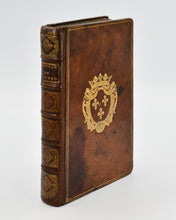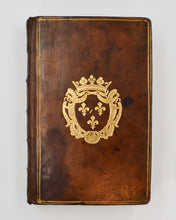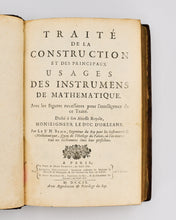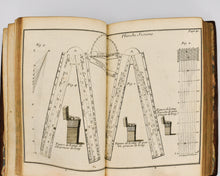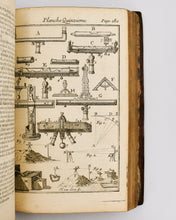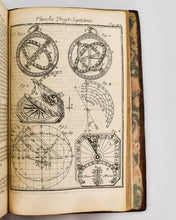
In a faked royal binding
BION, Nicolas. Traité de la construction et des principaux usages des instrumens de mathematique: avec les figures necessaires pour l’intelligence de ce Traité. Paris: Chez La Veuve de J. Boudot, J. Collombat, et J. Boudot fils. 1709.
8vo. Contemporary French sheep, later gilt armorial supralibros to boards (see below), within double fillet border, spine with raised bands lettered and tooled in gilt (rebacked preserving the original compartments), edges gilt over marbling, marbled endpapers, blue silk place marker; pp. [8], 347, [5], with 28 engraved plates by Harmanus van Loon, engraved vignette by Nicolas Guerard to p. [3], woodcut initials, head and tail pieces; extremities lightly worn, corners restored; some variable light toning, otherwise very good and clean; a few contemporary annotations in ink, contemporary correction to p. 377: “1725 e des suivantes. C’est à dire le 31 Marz et le 3 octob. L’etoile polaire at aussi le 1 Aóust, et le 14 Fevrier, la luire dela petite Ourse”.
First edition, a superb copy of “the most famous book devoted to instruments” (Knight).
Nicolas Bion (1652-1733), engineer and royal instrument-maker to the King of France, produced globes, sundials, astrolabes, and a wide variety of mathematical and astronomical instruments. Though few of his actual instruments survive, his Traité on mathematical instruments remains his enduring legacy, providing “a fairly complete list of instruments normally constructed during the first quarter of the eighteenth century” (DSB II, 133).
The Traité opens with elementary solid geometry (plates 1-2) and an introduction to the fundamental tools for geometrical drawing – many of which Bion himself manufactured, such as the signed goniometer illustrated on plate 3. Each instrument is treated systematically under the headings “Construction”, “Usage”, and “Example”. Among the many instruments described and illustrated are the sector (plate 6), portable sundials (plate 27), and water clocks (plate 28).
The book enjoyed great success across Europe: it was reissued in several later French editions, translated into English in 1723, and into German in 1726, ensuring its influence among mathematicians, engineers, and instrument-makers well into the eighteenth century.
The binding of the present copy, strictly contemporary, was embellished at a later date with gilt armorial supralibros imitating those of a prince légitimé (a legitimised son of the King of France) or one of his descendants. For comparison, see the bindings of Louis-Auguste de Bourbon, duc du Maine, and Louis-Alexandre de Bourbon, comte de Toulouse. The shield form here closely resembles Olivier pl. 2477, Fer no. 1, recorded on a book printed in 1741.
See Knight, History of Science 1660-1914, p. 202.
#2121534






